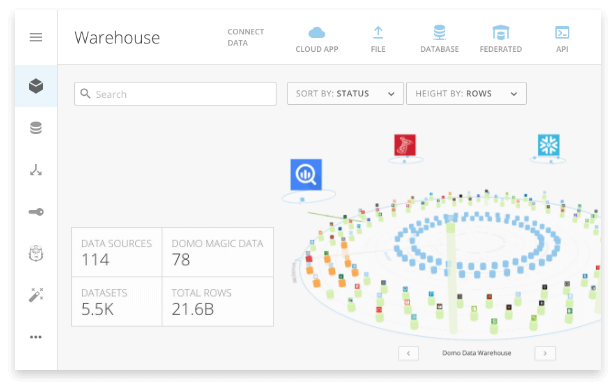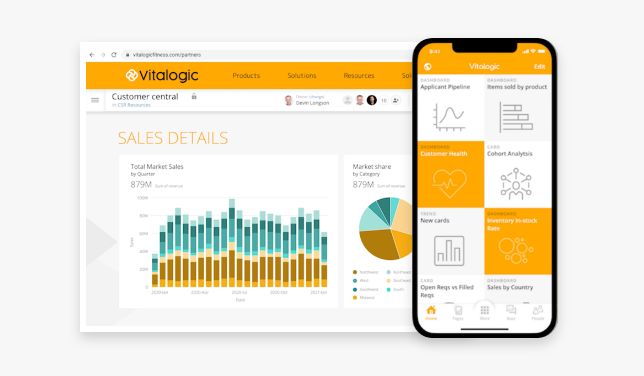Data integration in business intelligence
Data integration is an important part of any data technology solution. Data integration enables you to easily access all of the data you need to make informed business decisions and allows you to transform and combine data sources for accurate analysis. The insights that result from having your data contextualized are invaluable because they allow business users to quickly determine what actions should be taken. Furthermore, these insights can give rise to innovative business ideas, more efficient operations, opportunities for expansion, and more.
It’s important to have a solid foundation in place that allows you to easily access all of your data while simultaneously keeping costs under control. It’s also best to look atBI data integration as an investment rather than an expenditure because it provides returns across the entire organization—from individual departments to executive leadership, it informs the decision-making process. When properly implemented, organizations see increased productivity thanks to streamlined processes and the availability of high-quality information whenever necessary.
Cloud-based architecture is a key component of an effective data integration strategy. The reason for this is quite simple: cloud-based solutions allow companies to normalize their data across multiple systems and platforms and align their business on a single source of truth. A cloud-based tool also allows for real-time decision-making across multiple data sources.

Cloud-first design has significant benefits
Many software companies have tried to make the pivot from on-premises to cloud-based hosting and infrastructure with little success. Tools that were initially designed for on-prem don’t usually transition to the cloud without major product overhaul and development effort. Even years after an “on-prem to cloud” update, the UI of these tools usually demonstrates significant design flaws.
Tools that were designed as cloud-based solutions with data integration at their core have a significant advantage in today’s big-data world. This is typically highlighted by a user-friendly UI and features that are fully functional in the cloud. A modern cloud-based BI platform lets you easily access, connect to, transform, and visualize information from any source, whatever it may be—human capital management systems (HCM), customer relationship management systems (CRM), marketing automation solutions, human resources/employee engagement technologies, IT systems, finance, accounting, sales, etc.

Features of a data integration platform
Here are 3 primary features of a data integration platform:
1. Connect and normalize. Data is messy and you need to have it organized to derive value from it. Data sources are often siloed in various systems that do not communicate with one another. Without a modern data integration platform, this can often result in fragmented reporting and a lack of transparency in your business.
Data integration also allows you to transform, normalize, or prepare your data for analysis. It is not enough that all of your organization’s data has been connected, it is equally important that the data is formatted in such a way it can be easily consumed and analyzed by end-users.
As previously mentioned, data has a tendency to be dirty and needs to be transformed into something that is useful. Furthermore, data from multiple disparate source systems don’t always align well. Domo’s ETL tools make data harmonization simple for business users. Another key feature that differentiates Domo from its competitors is the product’s ability to process data at hyper speed. Domo’s data query engine, Adrenaline, is amazingly fast and allows users to make instantaneous queries on large datasets.
Domo’s connector suite has over 1,000 prebuilt connectors that allow its users to connect to almost any data source irrespective of size or volume. Many of these connectors are not found in any other software, making Domo a one-stop shop for your organization’s data needs.

2. Visualize and analyze. Once you have your data connected and transformed into something that is consumable, it’s time to visualize the information in meaningful ways so decision-makers can understand what they are seeing and take intelligent action on accurate information. A single visualization on its own is usually not enough to answer a complex business question. Interactive dashboards are useful in determining how a change in one area of your business impacts other areas. This type of visualization strategy allows for proactive management.
Whether you’re looking for a simple drag and drop ETL interface, a SQL query engine, or advanced data science scripting capabilities, Domo has pre-built features for every user persona in your organization. Domo comes equipped with over 150 chart types and over 7,000 custom maps so users can create their own custom dashboards to meet their needs. Domo also provides prebuilt templates by industry or use case to get users up and running quickly. When it comes to visualizing data, Domo enables business users to create interactive dashboards that allow them to seamlessly drill down into any level of detail and view metrics from different angles. Furthermore, these dashboards can be shared with other members in your organization who can add their own KPIs and collaborate on developing insights based on aggregated data from all of your data sources.

3. Support the creation of custom apps. No two companies have the same data challenges or workforce needs so it’s best for tools to support customization so organizations can build unique experiences that work perfectly for their specific situation. That means being able to create custom fields, reports, directories, widgets, charts, logos—whatever makes sense for what you’re trying to accomplish—without having any concerns about out-of-the-box platform limitations.
Tools should also be efficient for users showcasing a simple interface that allows development resources to build business applications quickly. Since each department within each company faces unique challenges, seamless data integration into custom applications can be challenging for many BI tools. A modern BI platform that allows for custom app development has significant advantages. When apps are developed within the platform that houses a company’s data, integration is seamless.
Data integration and modern BI solutions
Without the assistance of a full-stack, modern BI solution, the proliferation of data in complex organizations has made it extremely difficult for people to access and use their data. For business analysts and other stakeholders, the process of getting relevant data is expensive and time-consuming. Data integration powered by modern BI enables them to bring together their different datasets on a single platform, perform the necessary ETL, and build out actionable dashboard content without having to leave their BI tool.
Domo is a modern business intelligence tool that uses data integration and visualization to empower users of all capabilities and experience levels to gain insights and make the best possible decisions. Domo includes ETL tools, prebuilt connectors, an intuitive drag-and-drop interface for building apps, SQL query engine, advanced scripting capabilities for data science pros, multiple types of custom dashboards/visualizations including interactive drill-downs, 150+ chart types, and templates by industry use case. Within this platform, business users are able to maximize data integration by connecting with their data sources seamlessly via over 1,000 pre-built connectors or through custom integrations with APIs.
Check out some related resources:

Building Data Integrations on a Modern BI Platform

Domo Customer Stories: How Domo Customers Achieve Modern BI for All






